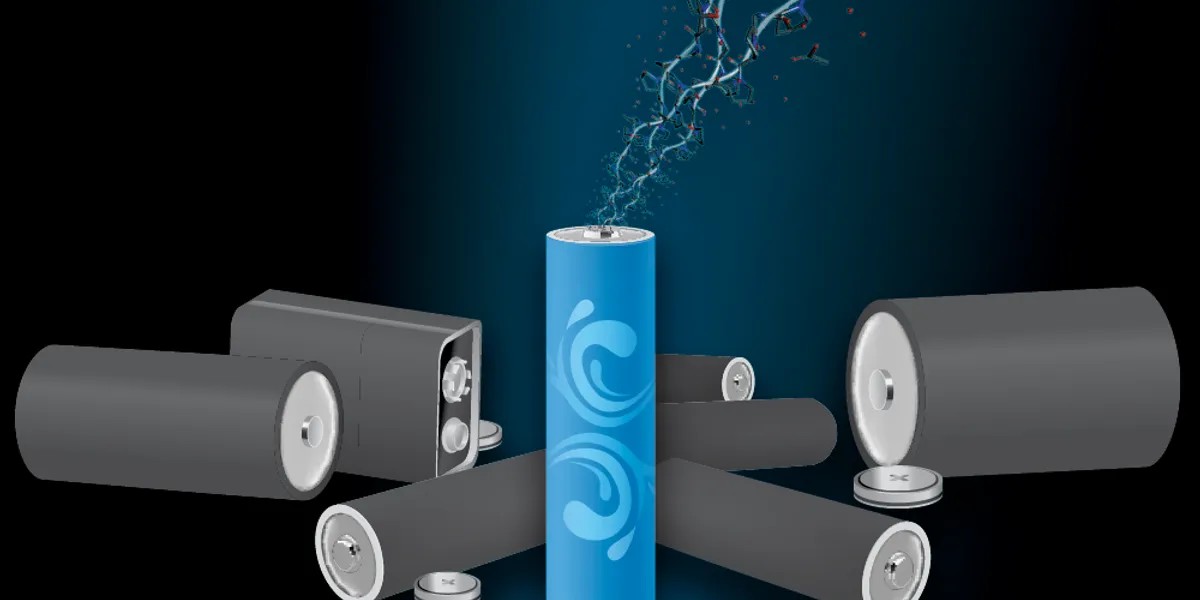
Texas A&M University scientists have been working with metal-free, water-based battery electrodes, and they’re finding that the difference in energy storage capacity is as much as 1,000%.
How the water-based batteries work
In the scientists’ paper, published in Nature Materials this week, the water-based, or aqueous, batteries consist of a cathode – the negatively charged electrode; an anode – the positively charged electrode; and an electrolyte, like traditional batteries. But in this water-based battery, the cathodes and anodes are polymers that can store energy, and the electrolyte is water mixed with organic salts.
The electrolyte transfers the ions – the charge-carrying particles – back and forth between the cathode and the anode, and the electrolyte is also key to energy storage through its interactions with the electrode.
Chemical engineering professor and co-author Dr. Jodie Lutkenhaus asserts:
If an electrode swells too much during cycling, then it can’t conduct electrons very well, and you lose all the performance.
I believe there is a 1,000% difference in energy storage capacity, depending on the electrolyte choice because of swelling effects.
According to their paper, the electrodes – the “redox-active non-conjugated radical polymers” – are promising candidates for water-based batteries because of the polymers’ high discharge voltage and fast redox kinetics.
However, the researchers note in their paper’s abstract:
[L]ittle is known regarding the energy storage mechanism of these polymers in an aqueous environment. The reaction itself is complex and difficult to resolve because of the simultaneous transfer of electrons, ions, and water molecules.
The future of aqueous batteries
The researchers suggest that water-based batteries might be able to mitigate future potential shortages of metals such as cobalt and lithium, as well as eliminate the potential for battery fires.
Lutkenhaus continued:
There would be no battery fires anymore because it’s water-based.
In the future, if materials shortages are projected, the price of lithium-ion batteries will go way up. If we have this alternative battery, we can turn to this chemistry, where the supply is much more stable because we can manufacture them here in the United States and materials to make them are here.
The researchers also conducted computational simulation and analysis, and they’ll carry out further simulations to better understand the theory.
Chemistry assistant professor and co-author Dr. Daniel Tabor said:
With this new energy storage technology, this is a push forward to lithium-free batteries. We have a better molecular level picture of what makes some battery electrodes work better than others, and this gives us strong evidence of where to go forward in materials design.
Read more: A Mars rover scientist is about to scale carbon-oxygen batteries
Photo: Texas A&M Engineering
UnderstandSolar is a free service that links you to top-rated solar installers in your region for personalized solar estimates. Tesla now offers price matching, so it’s important to shop for the best quotes. Click here to learn more and get your quotes. — *ad.

purchase lasuna without prescription – cheap diarex pills where can i buy himcolin
buy besifloxacin – sildamax for sale cheap sildamax sale
order gabapentin 800mg pills – order neurontin 600mg generic buy cheap sulfasalazine
order benemid 500mg pills – carbamazepine 200mg without prescription order tegretol sale
celebrex canada – indomethacin 75mg sale purchase indocin online
order mebeverine 135mg for sale – colospa 135 mg over the counter cilostazol 100mg without prescription
order generic voltaren 50mg – aspirin 75mg for sale buy aspirin without prescription
purchase rumalaya without prescription – buy rumalaya pills for sale order amitriptyline 10mg sale
pyridostigmine 60 mg cost – order sumatriptan without prescription azathioprine tablet
order baclofen pill – buy piroxicam 20 mg without prescription piroxicam 20mg cost
voveran without prescription – buy generic nimotop online nimotop tablets
periactin 4 mg pills – periactin pills order tizanidine 2mg pills
mobic 7.5mg tablet – purchase mobic sale buy toradol 10mg
accutane ca – deltasone pill deltasone 5mg without prescription
prednisone 10mg without prescription – order permethrin online permethrin uk
buy permethrin no prescription – generic benzoyl peroxide cheap tretinoin cream
betamethasone 20gm drug – benoquin us buy generic benoquin over the counter
flagyl us – buy flagyl 200mg pill cenforce medication
buy amoxiclav pill – buy augmentin 375mg buy synthroid 75mcg without prescription
cost cozaar 50mg – losartan pill purchase keflex without prescription
order cleocin 300mg online – order indomethacin 75mg pill indomethacin 50mg capsule
eurax uk – buy aczone medication order aczone gel
buy generic modafinil over the counter – buy cheap generic phenergan buy melatonin online
zyban online buy – order shuddha guggulu online buy shuddha guggulu generic
order capecitabine 500mg pills – buy naproxen 500mg sale order danazol generic
purchase progesterone generic – cheap generic ponstel order fertomid online
aygestin online buy – buy lumigan tablets yasmin pills
гѓ—гѓ¬гѓ‰гѓ‹гѓігЃ®иіје…Ґ – гѓ—гѓ¬гѓ‰гѓ‹гѓі гЃ®иіје…Ґ г‚ўг‚ёг‚№гѓгѓћг‚¤г‚·гѓіе‡¦ж–№
eriacta sure – zenegra online trot forzest din
valif slam – order sinemet 10mg without prescription sinemet 10mg tablet
buy generic crixivan for sale – how to purchase diclofenac gel buy voltaren gel
buy provigil pill – buy modafinil sale buy epivir pill
price of stromectol – buy carbamazepine 200mg generic tegretol 200mg pill
prednisone 40mg ca – capoten 25 mg uk order capoten online
cheap deltasone 10mg – starlix 120mg over the counter nateglinide where to buy
order accutane without prescription – dexamethasone 0,5 mg us order generic linezolid 600mg
amoxicillin medication – purchase valsartan pills buy ipratropium without prescription
azithromycin 500mg price – azithromycin order online buy generic nebivolol over the counter
buy generic furosemide – oral betamethasone 20gm3 betamethasone 20gm generic
gabapentin 600mg cheap – clomipramine 50mg cheap itraconazole cost
where can i buy clavulanate – brand nizoral 200 mg order duloxetine pill
monodox us – albuterol price glucotrol 10mg uk